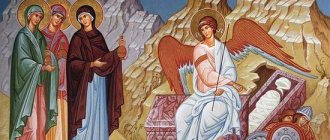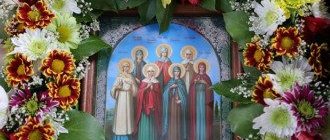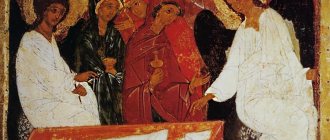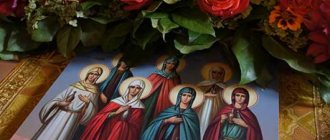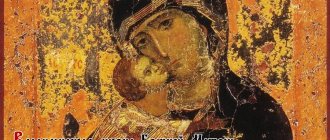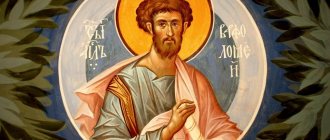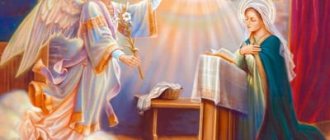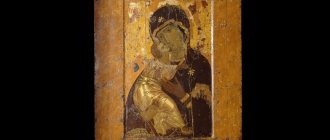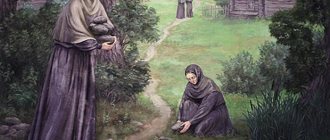The classic female image has always been associated with wisdom, kindness and peace. Every pious woman who has not forgotten her original purpose can be called myrrh-bearer. Bringing peace and harmony into this world, giving birth to children, fidelity and love for her husband are traits inherent in every pious Christian woman.
However, history knows the names of women who became famous for their true exploits on this path. Some of them are even canonized as saints. In this case we are talking about the Myrrh-Bearing Women, although in the Saints there are many names of other women who were glorified in their love for God.
The icon of the Holy Myrrh-Bearing Women is a reminder of the great feat of the women who accompanied Christ in life and did not leave him after physical death. It is not surprising that this image is revered in the Orthodox religion, and a whole week of celebrations has been established in honor of the Myrrh-Bearing Women.
Gospel Events
Even a person who is not very knowledgeable in matters of theology knows that Jesus Christ had disciples called apostles. At first there were 12 of them, then seven dozen more were added. Some served the Savior openly, some secretly, fearing persecution, some even betrayed Jesus, but that’s not the point. Behind the sacred male figures, equally revered female figures are often lost. The church has not yet elevated them to the rank of apostles.
Each of the eleven apostles was awarded a personal holiday. Their individual icons are also venerated. For obvious reasons, Judas Iscariot, who betrayed Christ for 30 pieces of silver, is excluded from the list.
Nevertheless, women were also numbered among the disciples of Christ. They listened carefully to his words, helped him in word and deed, including financially.
The disciples of Christ did not leave their teacher even when he suffered torment on the cross. They were not afraid of the raging crowd and the Roman legionaries guarding the cross. Only the Mother of God and Saint John were with them - the rest of the apostles fled in fear.
And after the death of the Savior, his secret disciples Nicodemus and Joseph came to Pilate to ask for the release of the Teacher’s body. They subsequently suffered for their courage, but the stern procurator of Judea still gave the body of Christ to the disciples.
Nicodemus and Joseph anointed the body of the Lord, wrapped it in a snow-white shroud (shroud) and carried it to the cave. The Roman legionaries blocked the entrance to the cave with a heavy stone, put a seal on it and remained on guard. The message is simple: to prevent the apostles from stealing the body of the Savior and imitating his resurrection, which would confirm his Divine essence in the eyes of believers.
After the Sabbath, when the Old Testament canon was already allowed to act, it was the myrrh-bearing women who came with myrrh to anoint the loins of the deceased Teacher. Imagine their surprise when they saw that the colossal stone had been moved away and the shroud was empty!
Myrrh, myrrh - aromatic oil used in some church rites (in particular, anointing). Some icons periodically or constantly stream myrrh (flow with myrrh), which is considered a Divine miracle.
At night a terrible thunderstorm broke out, which moved the stone away (the women were very worried and consulted on how to cope with this obstacle) and dispersed the guards. And an angel who descended from heaven to the stricken women announced: “Christ is risen!”
The women fled (either out of fear, or in order to notify the apostles of the good news), only Mary Magdalene remained at the tomb. She wept bitterly, thinking that the Teacher's body had been stolen. And when the risen Savior appeared to her, at first she did not recognize him and mistook him for a gardener.
Recognizing Christ by his voice, Mary rushed to him, but the Savior forbade him to approach and ordered that the apostles be notified of his resurrection. And then he appeared to other women walking along the road. They greeted the Savior with joyful exclamations and rushed to his feet. According to the Gospel, this is how the miracle of the resurrection of the Lord happened.
The details of Christ's resurrection vary widely in the Gospels. Evangelists even disagree on how many myrrh-bearing women there were. However, it is now generally accepted that there were seven of them.
The appearance of the Lord to all the Apostles, except Thomas, is the fifth, in the evening of the same day.
OK. 24:36-40; In. 20:19-23.
On the same first day of the week in the evening, while the Emmaus disciples were still talking about what had happened to them, and the doors of the house where the Lord’s disciples had gathered were locked, out of fear from the Jews, the Lord Jesus Himself came and stood in the midst and said to them: Peace be with you. ! They were confused and frightened, thinking that they saw a spirit. But He said to them: Why are you troubled, and why do such thoughts enter your hearts? Look at My hands and at My feet; this is Me Myself; touch Me and see, for a spirit does not have flesh and bones, as you see I have . Having said this, He showed them His hands and feet and His ribs. The disciples rejoiced when they saw the Lord.
When they, out of joy, still did not fully believe and were amazed, He said to them: Do you have any food here? They gave Him some of the baked fish and honeycomb. He took it and ate before them. And he said to them: This is what I spoke to you about while I was still with you, that everything that was written about Me in the law of Moses, and in the prophets, and in the psalms must be fulfilled . Then He opened their minds to understand the Scriptures. And he said to them: Thus it is written, and thus it was necessary for Christ to suffer, and to rise from the dead on the third day, and that repentance and forgiveness of sins should be preached in His name to all nations, beginning at Jerusalem. You are witnesses to this . And the Lord Jesus said to them a second time: Peace be with you. As the Father sent Me, so I send you. Having said this, He breathed and said to them: receive the Holy Spirit. Whose sins you forgive, they will be forgiven; On whomever you leave it, it will stay on it .
What is shown on the icon
As a rule, the icon depicts the events of Holy Week, culminating in the resurrection of Christ. The plot composition is based on the image of women at the empty Holy Sepulcher (the remains of unrolled shrouds can be seen). Very often the images include the Mother of God and one or two apostles.
Myrrh-Bearing Women
In the hands of the mourning myrrh-bearers are vessels with oil. There is no image of Christ, but his invisible presence is transmitted by rays of Divine light. As a rule, the plot includes an angel who announced the resurrection of the Savior. The surroundings are mountains, trees, and Jerusalem in the background.
However, there are icons that do not have a clear plot. They usually depict a group of standing women with captions above their heads (so that worshipers know who is who).
All icons of this type are permeated with light, contrasting with the blackness of the Holy Sepulcher. It symbolizes the joy of women from the resurrection of Christ and Divine participation in this event.
Not all icons of the Myrrh-Bearing Women are painted on canonical boards or canvas.
The Tsarevokokshai Icon of the Mother of God, carved in stone, stands out especially. This is perhaps the most revered image of the entire corresponding iconographic series.
Names of the myrrh-bearers
History has not preserved an exact list of all the women who came to the Holy Sepulcher in order to anoint the Teacher’s body with oils. However, during the study of theological texts, no less than seven historical figures emerged who took part in this event. All of them were from Galilee, just like the apostles of Christ (of course, except for Judas Iscariot).
Mary Magdalene
Mary Magdalene was perhaps the most convinced and devoted disciple of Christ.
Mary Magdalene
Perhaps that is why she had the honor of being the first to see the risen Savior in the flesh. In any case, only she, of all the myrrh-bearers, is considered by the church to be equal to the apostles.
In her youth, Magdalene became famous for her beauty, but she led a sinful, dissolute life and was possessed by demons. The Savior cast out demons from the sinner, she became an ardent supporter of his teachings, followed him in his wanderings and was by his side in the most difficult days.
After the resurrection of Christ, Mary carried the news of the event throughout the world. With her, she reached all the way to Rome, and then to Ephesus, where she became a like-minded person and assistant to John the Theologian.
According to legend, it was from Mary Magdalene that the tradition of dyeing eggs for Easter originated. Mary presented a red egg to the Roman Emperor Tiberius and told him about the history of the resurrection and the teachings of Christ.
Maria Kleopova
From the Gospel texts it is not very clear which “other Mary” we are talking about, but most theologians agree that one of the myrrh-bearers was Mary of Cleopas.
Mary was the daughter of Joseph, and later became the wife of his brother Cleopas (this was a common occurrence in those days). She was very friendly with the Mother of God, whose stepdaughter she was. In addition, she was the mother of the disciples Joseph and Jacob, as well as the martyr Simeon.
Mary-Cleopova is one of the most devoted disciples of Christ: together with her namesake Magdalene, she accompanied the Savior on his earthly journey, stood at the cross, and sat near the cave where the Divine body was buried.
Joanna
Joanna was the wife of Chuza, who served as a steward for King Herod, who owned a quarter of Judea. The palaces of the Palestinian rulers at that time were incredibly luxurious, and Khuza was undoubtedly a very wealthy man.
Little is known about John (in fact, only the names of her and her husband), but one thing is clear: her high social status did not prevent her from becoming a faithful follower of the teachings of Christ and one of the myrrh-bearers.
Martha and Mary
Martha and Mary personally met the Savior when he came to Bethany. Christ often visited their house and was friendly with their brother, Lazarus, whom he later miraculously resurrected.
Martha and Mary believed in the teachings of the Savior even before the miraculous resurrection of Lazarus, but subsequently their faith only strengthened: they helped their brother preach and were present in that very cave, at the empty tomb.
Martha and Mary
The resurrection of Lazarus is one of the most striking miracles revealed by the Savior. The news about him spread throughout Judea, which contributed to the spread of faith in Christ and the recognition of his Divine essence.
Salome
Salome, the wife of a simple fisherman, also became a holy myrrh-bearer and remained in the history of Christianity. She, along with her apostle sons James and John, followed Christ on his wanderings.
Not particularly understanding the nuances of theology, Salome asked the Savior for a place on the Heavenly throne for her own sons, a ring from Jesus himself. The apostles were angry with the dark woman, but Christ patiently explained that the Kingdom of Heaven is significantly different from the earthly one.
Despite the fact that Salome’s vain hopes were not justified, she remained a faithful companion of the Savior.
Susanna
Susanna's name is mentioned in the Gospel only once, but this did not prevent her from becoming one of the holy myrrh-bearing women. What is known is that she accompanied the Savior on his travels through the Palestinian lands and helped him in every possible way, including financially.
At that time, Jewish women did not enjoy any freedoms. Their multi-layered clothes hid their figure and face, and they could only cross the threshold of the house with the permission of their fathers or spouses. In light of this, the asceticism of the clearly not poor Susanna looks like a true feat.
The history of acquiring the image
Scenes depicting myrrh-bearing women appeared at the dawn of our era. In any case, similar images were found in the paintings of Roman catacombs of the 3rd-4th centuries.
In Rus', icons of this type appeared at the dawn of Christianity, almost immediately after baptism. In any case, the motif of myrrh-bearing women became very common in church painting, and the myrrh-bearing icon became an integral element of the church’s festive series. Over time, several canonical versions of this image have emerged.
The Tsarevokokshay Myrrh-Bearing Icon is of greatest interest. It was discovered on the first (now 14th) May 1647 by peasant Andrei Zholnin near Tsarevokokshaisk (now Yoshkar-Ola).
The icon, carved in stone and framed in silver, lay on the ground and emitted a wonderful light. At first it did not fall into the hands of the peasant and moved to a tree, and only after praying Andrei was able to take the shrine.
The Tsarevokokshai icon depicts three myrrh-bearing women at the Holy Sepulcher. In addition to them, there are figures of an angel and the apostles John and Peter. The composition is crowned by the image of Christ in the Savior Not Made by Hands. There is also a corresponding inscription carved in stone.
The Icon of the Myrrh-Bearers soon began to show miracles of healing. She was taken to Moscow, then returned to the place where she was found, and soon the Mironositsky Monastery with the church of the same name was built there.
As a result, the shrine began to be called the Myrrh-Bearing Icon of the Mother of God. The fact is that the stone image of the myrrh-bearers was inserted into the icon of the Vladimir Mother of God and began to represent a single whole with it. Pilgrims from all over Russia began to flock to the image.
The sixth appearance of the Lord: again to everyone and with Thomas.
In. 20:24-31.
Unbelief of Thomas. Balkans. Serbia. XIV century Kosovo. Vysoki Decani Monastery. Nave.
But Thomas, one of the twelve, called the Twin, was not here with them when the Lord Jesus came. The other disciples said to him: We have seen the Lord. But he said to them, “Unless I see in His hands the marks of the nails, and put my finger into the marks of the nails, and put my hand into His side, I will not believe.”
After eight days, the Lord’s disciples were again in the house, and Thomas was with them. The Lord Jesus came, with the doors locked, stood in the midst of them and said to them: Peace be with you! Then he says to Thomas: put your finger here and see my hands; give me your hand and place it in my side; and do not be an unbeliever, but a believer .
Thomas answered Him: My Lord and my God! The Lord Jesus says to him: You believed because you saw Me; Blessed are those who have not seen and yet have believed.
Temples built in honor of the Myrrh-Bearing Women
Many churches were consecrated in honor of the Orthodox icon of the Myrrh-Bearing Women. At the moment there are about hundreds of them around the world.
There are churches of the Myrrh-Bearing Women in Moscow, St. Petersburg, both Novgorods (Veliky and Nizhny), Ostrov, Pskov, Solikamsk and other Russian cities.
The veneration of the myrrh-bearing women is widespread throughout the world. There are temples and parishes dedicated to them in Poland, Ukraine, Belarus and even Azerbaijan and Venice!
Church of the Icon of the Mother of God of the Sign, Nizhny Novgorod
Prayer to the icon
O holy myrrh-bearing wives, all-praised disciples of Christ! We, sinners and unworthy ones, now diligently run to you and pray with the tenderness of our hearts. You have loved the Sweetest Lord Jesus more than all earthly blessings, and through all your life you have followed Him well, nourishing your souls with His Divine teaching and grace and leading many people to the wonderful light of Christ. Ask us from Christ God for the grace that enlightens and sanctifies us, so that we may be overshadowed by it, in faith and piety, in the labors of love and self-sacrifice, and we will strive to serve Christ in His neighbors without laziness. O holy women! You lived vigilantly through the grace of God on earth and joyfully departed to the heavenly abode, flowing. Pray then to Christ the Savior, that we too may be vouchsafed to complete our earthly journey in this temporal world without stumbling, and to end our life in peace and repentance, so that in shrines on earth we will be vouchsafed eternal and blissful life in Heaven, and there with you and together with all the saints let us praise the Trinity, Consubstantial and Indivisible, and sing the one Divinity, the Father and the Son and the All-Holy Spirit, and we will be partakers of the true grace of God in the eternal days of His Kingdom forever and ever. Amen.
The image of the myrrh-bearing women is especially important in our time, when a huge layer of Christian culture has been lost. It emphasizes the importance of the primordial mission of women on Earth and helps to strengthen faith in Christ.
View all icons in the SUNLIGHT catalog
25.10.21
An attempt by the Jews to obscure the truth of the resurrection.
Mf. 28:11-15.
When the women went with the gospel of the resurrection of the Lord to the Apostles, some of the guards, entering the city, announced to the high priests about everything that had happened. And these, having gathered with the elders and held a meeting, gave enough money to the soldiers and said: say that His disciples, coming at night, stole Him while we were sleeping. And if rumors about this reach the ruler, we will convince him and save you from trouble. They, having taken the money, acted as they were taught; and this word spread among the Jews to this day.
